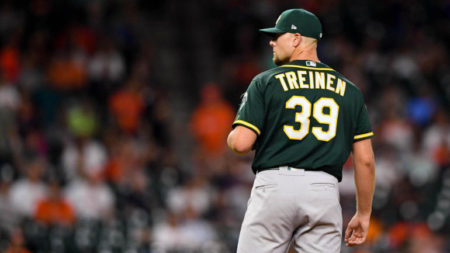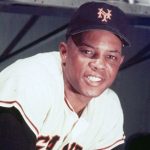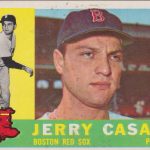Relievers, Wildcards and Apple Pie—Part III
 Part III of a three-part series (see Part I, Part II)
Part III of a three-part series (see Part I, Part II)
The Aftermath: Pitching, Baseball, and America
So, for one night at least, the Athletics looked like what they were, a small-market club up against a big market, tough opponent ready for them this time. And the Yankees had their best player back in the lineup. Aaron Judge. So, as bad as the Yankees had looked a month earlier out in Oakland, when the Athletics took two of three, they looked that good, that composed and that that confident in the Wild Card game.
As for the Athletics, they had yet another one of their magical seasons ended too early, by the Yankees. It would’ve been exciting to watch them battle the Red Sox in the Divisional Series.
The message of this game was that while “openers” might be a great regular season strategy, the playoffs, especially one-game, winner-take-all formats, require pitchers who minimize mistakes. Pitchers who can be trusted. Pitchers who’ve done it before.
Had Oakland gone with Blue Moon Odom or Vida Blue or Dave Stewart or even (the once effective) Sonny Gray to throw this game, they more than likely would’ve abandoned the opener. But they didn’t have these pitchers available. Injuries (their wonderful lefty Sean Manaea had been injured over the summer and declared out for the rest of the year) and lack of depth forced their hand. So, they did the best they could.
Ron Darling commenting about this relief-pitcher-by-committee-start during the telecast made a pithy observation. He said that after Liam Henricks had served up the two-run homer to Judge, that all the pitchers who would enter the game for Oakland would have to be effective if Oakland was to have a chance. They couldn’t bring in another Liam Hendriks. The pitchers would need to be on their games. And if not, then the Athletics would stumble. And given that the Athletics might throw out six or seven pitchers, that’s a burden for all their relievers, to be “on” for such an important game. And as we know, no manager can ever know which of his pitchers will be “on” on a given night.
The manager closes his eyes (maybe), points his finger, and says, “You, Peter Pitcher, you’re starting tonight.” And then hopes. Of course, there’s a huge difference choosing and hoping between Jon Lester and Liam Hendriks.
As in baseball, as in life, sometimes it works and the manager is a genius, and sometimes it doesn’t. The opener strategy left the Athletics high and dry in the Wild Card game. And even their use of Blake Treinen betrayed them.
Maybe pitchers should not be billed as temps. They should make a statement every time they pitch. And if they’re not good enough to face their opposite platoon, then maybe they should not be a major leaguer. Pitchers should throw an inning, at least. They used to throw 400, they should be forced to throw one every time they enter a game.
Maybe to effectively use a pitcher out of his comfort zone, a manager has to establish the usage patterns in regular season games when a loss doesn’t matter as much. Allow the pitcher to find a comfortability zone in the fourth inning or sixth. There’s always tomorrow’s game. Rather than the urgency of a playoff game.
But whatever the comfort level, it’s one inning at a time.
Perhaps there’s something to be said for established roles. For convention. For regularity. For the same old thing. There’s a reason the old cliche, ‘practice makes perfect,’ is still around. Because it’s true.
So practice one inning at a time. Out of the bullpen. No more six pitchers to record seven outs. The game will move faster with fewer changes. (Think of the last minute of a close NBA game with one time-out after another. The last minute with time-outs and commercials can last half an hour. Forever. And it’s boring.)
Sports should be a dramatic spectacle. Full of assumptions. Fears. Expectations. Hyperbole. And then the game itself. In this case finally played in the cool temperatures of October (so many days and months since the season’s frigid April beginning).
The game was an evening of ritual. An evening of experiments. Pitchers out of place. Excitement galore even though the Yankees seemed moribund half the game.
But the game was more than a game. It was a community bound together in anticipation. Americans on the edge of their seats. No such thing as Democrats and Republicans at this baseball game. That’s what makes these games so wonderful. Being a baseball fan is enough. Being an America is enough.
And then the mysteries of the game unfold. The marvel of chance. The wonder of this pastime. Our pastime. The fervor. The passion. The joys of being an apolitical American for one night. The only red and blue that mattered was the luscious red, white, and blue of the glorious American flag waving in the breeze.
If only all of our public discourse was like a baseball game. We’d be united. Okay, it was city against city. East against west. But all of us believed in the sanctity of the round, cowhide baseball. The diamond. All of us worshipping at the baseball cathedral.
And the years and years of history that unites Babe Ruth, Reggie Jackson and Khris Davis were on display in the batter’s box. Mashers all, those hitters could be seen in the beautifully brocaded tapestry of Americana and the mythic call we all still revere, PLAY BALL! The pitcher winds up and …
The hits. The outs. The errors.
The opener. The weapon.
Pure excitement. The roar of the crowd.
But, watching the game gave rise to some questions. What about a 27-man roster? Suppose only 12 of those roster spots could be filled by pitchers? And relief pitchers must face three batters minimum once they’re brought in. Enough of this one hitter and done. Perhaps it’s more appropriate to say a relief pitcher must record three outs before he can be replaced.
Think about that as balls thud into leather, or chomp off ash and maple bats, or whisk through the air. The game is not only physical. it’s cultural.
In our brains.
We believe in the message, or we did. Or, do we just want consistency? The hit and run. The bunt. The pivot at second base. All of these balletic movements reminding us who we are, what we love, and why baseball matters, no matter who the players are.

























